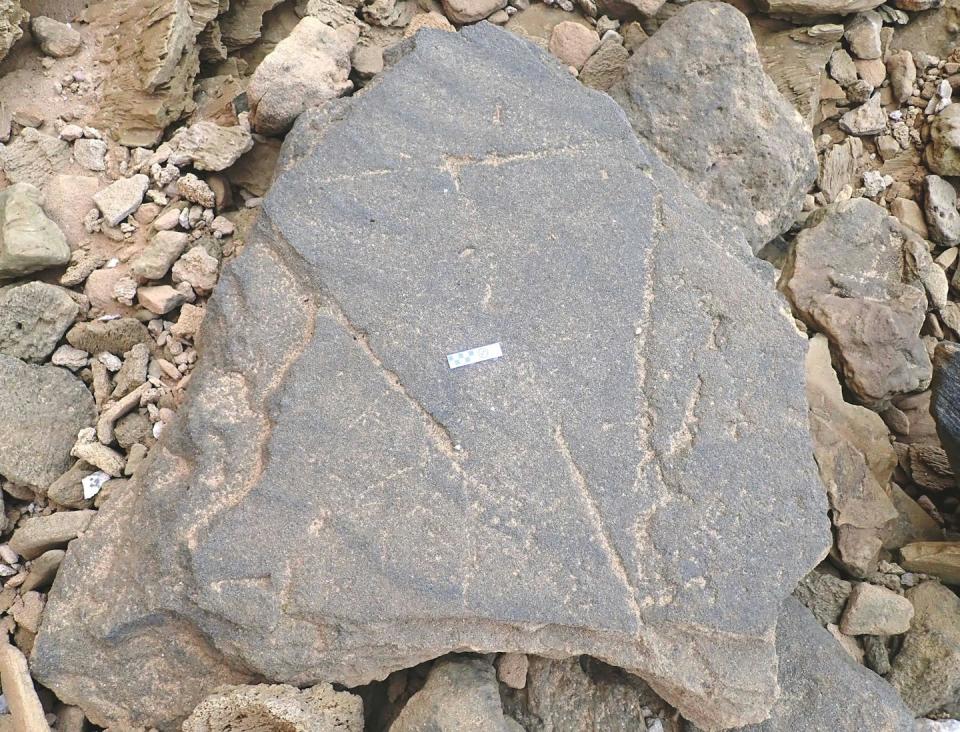Scientific breakthroughs can happen in the strangest ways and places. Alexander Fleming discovered penicillin due to mold growing in a Petri dish left while on vacation. In the 9th century, Chinese priests wanted to make an elixir of immortality; instead they discovered gunpowder.
Our remarkable discovery took place on a rugged and remote coastline east of Still Bay on the Cape south coast of South Africa. The tide was receding, and three members of our ichnology team (people who work on tracks and traces) were searching for newly exposed Pleistocene vertebrate track sites in aeolian rocks (cemented dunes).
Up ahead we saw a large rock falling from the cliff above. Its surface had a pattern of large triangular linear grooves, complete with an almost perfect bisecting groove. The sides of the triangle were nearly one meter long. After extensive research, we concluded that these burrows must have been made by our human ancestors in the Middle Stone Age on a dune surface consisting of unconsolidated sand. The patterns are probably between 143,000 and 91,000 years old.
It was an important discovery in an important place. Abundant evidence along this coastline suggests that this was an area where our distant ancestors became truly modern, using fire as an engineering tool and creating abstract images.
Read more: What triangular patterns in rocks can reveal about human ancestors
But there was a problem. On a later visit we found a smaller rock nearby with a similar triangular feature. It was later destroyed, probably because storm waves or high tides shook it and toppled it over. We knew that if we did nothing, the larger rock would inevitably suffer a similar fate. From our point of view, this is one of the most important rocks in the world: it takes us back to our roots as a species and shows what kind of “proto-art” we managed to create so long ago.
So we carried out an unusual mission: a “rescue” operation designed to move approximately 500 kilograms of rocks to safety in a museum.
A coordinated mission
Given the size and weight of the rock, there was only one way to remove it: a helicopter, a skilled pilot, and a strong net attached to a long-gauge cable.
Our research team raised funds through paid contributions to a book project. This money was spent on hiring a private helicopter and pilot, as well as deploying the ground crew that day. We also received approval from the owner of the private land where the rock is located. Since the rock is a valuable heritage item, we also needed permission from the state heritage authority to proceed.

It was a frustrating process. The rock may have broken or fallen into the sea while being lifted from the edge of the cliff. However, September 29, 2022, which we called Recovery Day, went smoothly. The ground crew and helicopter pilot cooperated perfectly. Minutes after being lifted from the remote site, the rock was located safely on the pallet of a truck at the local airport. From there began a very careful journey to the Blombos Archaeological Museum in nearby Still Bay. Here it was lifted and gently replaced by a dozen volunteers.
The rock was then covered and placed in the exhibit along with interpretive text panels. It participates in similar exhibitions at the museum; grooves were an example of an amoglyph; It was a term we coined to describe a pattern that humans had created in the sand, now cemented and then resurfaced, clearly visible in the rocks.
Attributing meaning to these geometric patterns made by our distant ancestors long ago is not our area of expertise. Still, we couldn’t help but notice the similarity of the triangle shape to a supposed fertility symbol found in France and dated to around 38,000 years ago. If the pattern on our rock represents the same motif, it would not be the first time that South African discoveries have pushed back in time what is considered an Upper Palaeolithic Eurasian phenomenon.
Our research team now sleeps better at night knowing that this priceless piece of our human heritage has been saved and is available for others to view, appreciate and critique.
More to discover
Luckily, there was an unexpected bonus. Next to the eroded remains of the second rock, our ground team noticed a third rock face that was not previously apparent. Near one edge was a separate pair of cavities that met at a 69-degree angle, forming what may have been part of another triangular feature.
This is an area we will definitely return to again and again, in the hope that tidal forces can turn over other rocks before they destroy them, offering us the opportunity to see and perhaps rescue more amoglyphs.
This article is republished from The Conversation, an independent, nonprofit news organization providing facts and authoritative analysis to help you understand our complex world. Written by: Charles Helm, Nelson Mandela University and Jan Carlo De Vynck, Nelson Mandela University
Read more:
The authors do not work for, consult, own shares in, or receive funding from any company or organization that would benefit from this article, and have disclosed no relevant affiliations beyond their academic duties.